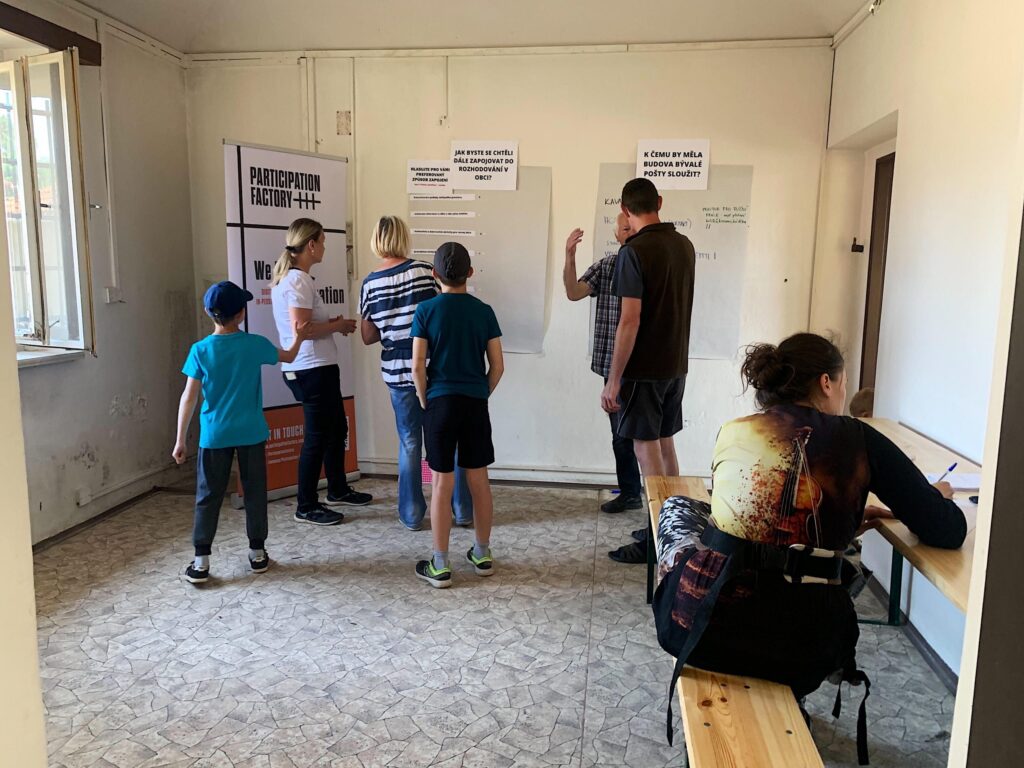Want a guide to making an impactful community meeting in a small village? Take inspiration from our recent experience in the village of Hrobce in the Ústí nad Labem Region in the Czech Republic.
On a sunny Saturday, we held a participatory community meeting that had the purpose to involve citizens in the process of finding a use case for the former post office building and to obtain relevant suggestions for the future management of the building in the small village of Hrobce. In order to allow the citizens to see the premises for themselves, the building doors were opened for them before lunch and remained so until late afternoon. All this with the personal presence of Mayor Kateřina Hlaváčová. However, only open doors would not bring results to the village. Neither would the refreshments and barbecue. Not even a sit-down and a chance to have a neighborly chat. All these activities pleasantly framed the participatory process that became a natural part of the place. Moreover, the result was much more than just an answer to a key question about the future use of the former post office.
In two rooms, visitors were given the opportunity to reflect and at the same time share their opinions and suggestions in writing. It was a space of an animated debate and conciliatory nodding at the village’s current state. Above all, citizens were given a chance to reflect on the village in which they live. The five questions were by no means complex. However, citizens do not ask themselves any of those questions in their daily life.
The obvious question was the one about the future use of the former post office. There was strong support for the proposal to use the building as a café and space for handicrafts (e.g. basket weaving, ceramics workshop). At the same time, it became clear that there were people in the village who could help manage creative activities, and using local human resources would therefore be a logical choice. There were many more wishes and suggestions. The final decision will be up to the municipal leadership.
However, it would be a real shame to not keep asking other questions, and so we did. For example, we asked what the people of Hrobce like about the village and what they dislike. What is lacking in the village and how they would like to be involved in decision-making on municipal affairs. The answers from the citizens themselves are worth gold to the council. And when citizens see that their opinion is given due attention, they are more motivated to take an interest in what is going on in the municipality and become actively involved.
This was also confirmed by the “dot” voting, in which citizens voted for their preferred way of involvement in decision-making in the municipality. Community and voluntary activities for the development of the municipality received the most votes, followed by the declared willingness to participate in regular public meetings, to express their opinion through a questionnaire or survey, or to receive information about what is happening in the municipality through their smartphones.
Thanks to the answers of the citizens, the municipality’s leadership has indicators of the direction for further development or validation of the steps already taken. As part of the modernisation of communication with its citizens, Hrobce, for example, uses the Munipolis app. The functionalities of the application include informing citizens via mobile phone or inviting them to a questionnaire survey. This corresponds nicely with the options chosen by the participants regarding involvement in the management of the municipality.
Even citizens without the right to vote have the right to express their opinion. That is why we have also prepared a creative workshop for children of all ages. The older ones were able to present their ideas about the use of the former post office as a collage. For the younger ones, we tried to influence their creativity as little as possible and just let their imagination work.
Village participation has its own specificities, and one of them is a smaller community, in which social ties tend to be stronger. The smaller number of people in a smaller space also makes it more likely for the unofficial channels of communication to operate more effectively. However, creating the conditions to foster civic engagement contributes to the development of democracy in any setting, even a small village. Another positive impact of this approach is to increase the efficiency of decision-making processes and create a dialogue between the city leadership and the citizens themselves, which ultimately benefits both parties.
Need help with a specific project? Contact us: info@participationfactory.com

